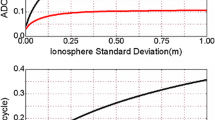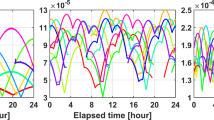Abstract
Carrier phase observations are commonly used in high-precision GNSS positioning applications, such as precise point positioning and real-time kinematic positioning, due to their millimeter precisions. Hence, it is a crucial module to handle cycle slips and short-time signal interruptions when phase observations are involved, which otherwise will lead to a time-consuming re-initialization. With the gradual GNSS modernization, jointly using observations from multi-GNSS and multi-frequency tends to be a hotspot application pattern for high-accuracy positioning. In this contribution, we will present a geometry-based ionosphere-weighted approach to estimate integer cycle slips in an integrated adjustment, which is universally applicable to arbitrary number of frequencies of GNSS systems. Different from the traditional methods, where cycle slips are processed in a satellite-by-satellite mode based on geometry-free combinations, we take full advantage of the mutual correlations between multi-frequency, between satellites and between systems embodied in the receiver coordinate parameters. When it is unable to effectively fix the full set of cycle slips, we further propose to partially fix the subset of cycle slips that can be reliably fixed. Performance of the proposed method is validated by extensive experiments using undifferenced dual/triple-frequency BDS data, dual-frequency GPS data and triple-frequency BDS \(+\) dual-frequency GPS data. The results show that the proposed method can effectively fix continuous cycle slips in case of small/large sampling intervals and connect the data gaps up to a few minutes with high success rates.













Similar content being viewed by others
References
Akaike H (1974) A new look at statistical model identification. IEEE Trans Autom Control 19(6):716–723
Banville S, Langley RB (2013) Mitigating the impact of ionospheric cycle slips in GNSS observations. J Geod 87(2):179–193
Blewitt G (1989) Carrier phase ambiguity resolution for the Global Positioning System applied to geodetic baselines up to 2000 km. J Geophys Res 94(B8):10187–10203
Blewitt G (1990) An automatic editing algorithm for GPS data. Geophys Res Lett 17(3):199–202
Cai C, Liu Z, Xia P, Dai W (2013) Cycle slip detection and repair for undifferenced GPS observations under high ionospheric activity. GPS Solut 17(2):247–260
Chen D, Ye S, Zhou W, Liu Y, Jiang P, Tang W, Yuan B, Zhao L (2016) A double-differenced cycle slip detection and repair method for GNSS CORS network. GPS Solut 20(3):439–450
Dach R, Hugentobler U, Fridez P, Meindl M (2007) Bernese GPS software version 5.0. Astronomical Institute, University of Bern
Dai L, Wang J, Rizos C, Han S (2003) Predicting atmospheric biases for real-time ambiguity resolution in GPS/GLONASS reference station networks. J Geod 76(11):617–628
Dai Z, Knedlik S, Loffeld O (2009) Instantaneous triple-frequency GPS cycle-slip detection and repair. Int J Navig Obs. https://doi.org/10.1155/2009/407231
de Lacy MC, Reguzzoni M, Sansò F, Venuti G (2008) The Bayesian detection of discontinuities in a polynomial regression and its application to the cycle-slip problem. J Geod 82(9):527–542
de Lacy MC, Reguzzoni M, Sansò F (2012) Real-time cycle slip detection in triple-frequency GNSS. GPS Solut 16(3):353–362
Dong D, Bock Y (1989) Global Positioning System network analysis with phase ambiguity resolution applied to crustal deformation studies in California. J Geophys Res 94(B4):3949–3966
Feng Y (2008) GNSS three carrier ambiguity resolution using ionosphere-reduced virtual signals. J Geod 82(12):847–862
Feng Y, Li B (2008) A benefit of multiple carrier GNSS signals: regional scale network-based RTK with doubled inter-station distances. J Spat Sci 53(2):135–147
Hatch R (1982) The synergism of GPS code and carrier measurements. In: Proceedings of the third international symposium on satellite Doppler positioning at Physical Sciences Laboratory of New Mexico State University, vol 2, Feb. 8–12, pp 1213–1231
Henkel P, Oku N (2015) Cycle slip detection and correction for heading determination with low-cost GPS/INS receivers. In: VIII Hotine-Marussi symposium on mathematical geodesy, Springer, pp 291–299
Huang L, Lu Z, Zhai G, Ouyang Y, Huang M, Lu X, Wu T, Li K (2016) A new triple-frequency cycle slip detecting algorithm validated with BDS dat. GPS Solut 20(4):761–769
Ju B, Gu D, Chang X, Herring T, Duan X, Wang Z (2017) Enhanced cycle slip detection method for dual-frequency BeiDou GEO carrier phase observations. GPS Solut 21(3):1227–1238
Kirkko-Jaakkola M, Traugott J, Odijk D, Collin J, Sachs G, Holzapfel F (2009) A RAIM approach to GNSS outlier and cycle slip detection using L1 carrier phase time-differences. In: IEEE workshop on signal processing systems, 2009. SiPS 2009, pp 273–278
Leandro RF, Santos MC, Langley RB (2006) UNB neutral atmosphere models: development and performance. ION NTM (2006) Monterey. California, USA, pp 564–573
Leick A (2004) GPS satellite surveying, 3rd edn. Wiley, New York
Li X, Zhang X, Ge M (2011) Regional reference network augmented precise point positioning for instantaneous ambiguity resolution. J Geod 85(3):151–158
Li Z, Yuan Y, Li H, Ou J, Huo X (2012) Two-step method for the determination of the differential code biases of COMPASS satellites. J Geod 86(11):1059–1076
Li B, Shen Y, Feng Y, Gao W, Yang L (2014a) GNSS ambiguity resolution with controllable failure rate for long baseline network RTK. J Geod 88(2):99–112
Li B, Verhagen S, Teunissen PJG (2014b) Robustness of GNSS integer ambiguity resolution in the presence of atmospheric biases. GPS Solut 18(2):283–296
Li B, Qin Y, Li Z, Lou L (2016) Undifferenced cycle slip estimation of triple-frequency BeiDou signals with ionosphere prediction. Mar Geod 39(5):348–365
Lichten SM, Bar-Sever YE, Bertiger EI, Heflin M, Hurst K, Muellerschoen RJ, Wu SC, Yunck TP, Zumberge JF (1995) GIPSY-OASIS II: a high precision GPS data processing system and general orbit analysis tool, technology 2006. In: NASA technology transfer conference, Chicago, Illinois, 24–26 Oct 1995
Liu Z (2011) A new automated cycle slip detection and repair method for a single dual-frequency GPS receiver. J Geod 85(3):171–183
Liu J, Ge M (2003) PANDA software and its preliminary result of positioning and orbit determination. Wuhan Univ J Nat Sci 8(2):603–609 (in Chinese)
Liu X, Tiberius C, Jong KD (2004) Modelling of differential single difference receiver clock bias for precise positioning. GPS Solut 7(4):209–221
Liu T, Yuan Y, Zhang B, Wang N, Tan B, Chen Y (2017) Multi-GNSS precise point positioning (MGPPP) using raw observations. J Geod 91(3):253–268
Melbourne WG (1985) The case for ranging in GPS-based geodetic systems. In: Proceedings of the first international symposium on precise positioning with the Global Positioning System, Rockville, 15–19 Apr, pp 373–386
Teunissen PJG (1995) The least-squares ambiguity decorrelation adjustment: a method for fast GPS integer ambiguity estimation. J Geod 70(1–2):65–82
Teunissen PJG (1998) Success probability of integer GPS ambiguity rounding and bootstrapping. J Geod 72(10):606–612
Teunissen PJG (2018) Distributional theory for the DIA method. J Geod 92(1):1–22
Teunissen PJG, De Bakker PF (2012) Next generation GNSS single receiver cycle slip reliability. In: VII Hotine-Marussi symposium on mathematical geodesy. Springer, Berlin, pp 159–164
Teunissen PJG, de Bakker PFD (2013) Single-receiver single-channel multi-frequency GNSS integrity: outliers, slips, and ionospheric disturbances. J Geod 87(2):161–177
Teunissen PJG, Montenbruck O (2017) Springer handbook of global navigation satellite systems. Springer, Berlin
Teunissen PJG, Verhagen S (2007) On GNSS acceptance tests. In: Proceedings of the international global navigation satellite systems society IGNSS symposium 2007, IGNSS, Sydney, pp 1–13
Verhagen S, Teunissen PJG (2013) The ratio test for future GNSS ambiguity resolution. GPS Solut 17(4):535–548
Verhagen S, Li B, Teunissen PJG (2013) Ps-LAMBDA: ambiguity success rate evaluation software for interferometric applications. Comput Geosci 54:361–376
Wang J, Stewart MP, Tsakiri M (1998) A discrimination test procedure for ambiguity resolution on-the-fly. J Geod 72(11):644–653
Wang S, Li B, Li X, Zang N (2018) Performance analysis of PPP ambiguity resolution with UPD products estimated from different scales of reference station networks. Adv Space Res 61:385–401
Wei M, Schwarz KP (1995) Fast ambiguity resolution using an integer nonlinear programming method. In: Proceedings of the ION GPS-1995, Palm Springs CA, pp 1101–1110
Wübbena G (1985) Software developments for geodetic positioning with GPS using TI-4100 code and carrier measurements. In: Proceedings of the first international symposium on precise positioning with the global positioning system, Rockville, 15–19 Apr, pp 403–412
Zhang Q, Gui Q (2013) Bayesian methods for outliers detection in GNSS time series. J Geod 87(7):609–627
Zhang X, Li X (2012) Instantaneous re-initialization in real-time kinematic PPP with cycle slip fixing. GPS Solut 16(3):315–327
Zhang X, Li P (2016) Benefits of the third frequency signal on cycle slip correction. GPS Solut 20(3):451–460
Zhang B, Teunissen PJG (2015) Characterization of multi-GNSS between-receiver differential code biases using zero and short baselines. Sci Bull 60(21):1840–1849
Zhang B, Teunissen PJG, Yuan Y (2017) On the short-term temporal variations of GNSS receiver differential phase biases. J Geod 91(5):863–572
Zhao Q, Sun B, Dai Z, Hu Z, Shi C, Liu J (2015) Real-time detection and repair of cycle slips in triple-frequency GNSS measurements. GPS Solut 19(3):381–391
Zhou Z, Li B (2017) Optimal doppler-aided smoothing strategy for GNSS navigation. GPS Solut 21(1):1–14
Zumberge JF, Heflin MB, Jefferson DC, Watkins MM, Webb FH (1997) Precise point positioning for the efficient and robust analysis of GPS data from large networks. J Geophys Res 102(B3):5005–5017
Acknowledgements
This study is sponsored by the National Natural Science Funds of China (41622401, 41574023), the Scientific and Technological Innovation Plan from Shanghai Science and Technology Committee (17511109501, 17DZ1100802 and 17DZ1100902), the National Key Research and Development Program of China (2016YFB0501802) and the Fundamental Research Funds for the Central Universities.
Author information
Authors and Affiliations
Corresponding author
Rights and permissions
About this article
Cite this article
Li, B., Qin, Y. & Liu, T. Geometry-based cycle slip and data gap repair for multi-GNSS and multi-frequency observations. J Geod 93, 399–417 (2019). https://doi.org/10.1007/s00190-018-1168-5
Received:
Accepted:
Published:
Issue Date:
DOI: https://doi.org/10.1007/s00190-018-1168-5




